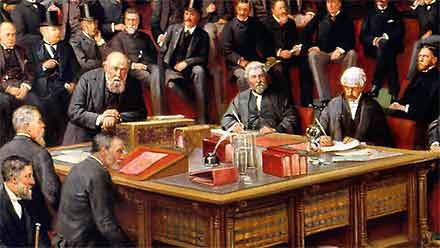The Irish 'Home Rule' Debate
© 2007
Armchair Travel Co. Ltd. - This page may be used for non-commercial purposes
ONLY!
![]()

[ Play
Narrated and Animated Movie ! ] This painting shows the House of Lords viewed from the south east - that is looking away from the throne end. The Lord Chancellor seated is Lord Herschell. The Marquess of Salisbury is standing at the despatch box. For some reason, the clock on the gallery is not shown.
Home Rule - a movement to secure internal autonomy for Ireland within the British Empire.
During the early 1880's the Liberal Leader William Gladstone began to call for 'Home Rule' for the Irish. The first 'Home Rule Bill' in the British Parliament was introduced by Gladstone's government in 1886. This was defeated in the House of Commons.
Problems within Ireland escalated between the opposing religious factions, and so the British Government decided to adopt a policy of Unionism - the idea being to preserve the existing Union between England and Ireland.
Gladstone introduced a second Home Rule Bill in 1893, but this was defeated in the House of Lords. The Conservatives then attempted to quell the debate by effecting some moderate reform.
When the Liberals returned to power in 1905 there came yet another effort to establish a measure of self-government within Ireland, and in 1912 the Third Bill was introduced by the new Ministry. This Bill was passed twice in the House of Commons, but was defeated both times in the House of Lords. Protestant Ulster then began to resist being incorporated into a self-governing Ireland, and Civil War in Ireland seemed imminent.
However, in 1914 the Home Rule Bill of 1912 passed the House of Commons for the third time, and according to the Parliament Act of 1911 (which had just been passed), validation from the House of Lords was no longer necessary. The Bill was finally passed on September 18th, 1914.
Unfortunately, around the same time World War I had broken out and so the question of Home Rule was postponed. Thousands of Irishmen, both Catholic and Protestant, set aside their differences and united with the rest of the British forces to fight the War. However, religious tensions were once again heightened by the Easter Rising of 1916.
Following the War, the Coalition Government of Lloyd George attempted to deal with the increasingly difficult situation in Ireland. The 'Government of Ireland' Act of 1920 created two moderately self-governing units. The nine Protestant counties of Ulster formed one of these groups (later becoming known as Northern Ireland), while the other three remaining counties of Ulster combined with the twenty three counties of the rest of Ireland. The North settled for Home Rule for itself, but ironically it was the Catholic South (for whom it had originally been intended) who rejected Home Rule and briefly fought a war with Britain before agreeing to the Anglo-Irish Treaty of 1921-1922.
[ Virtual
Tour ] [ Main Topics
Index ]

Additional Information on
The Irish 'Home Rule' Debate
During the nineteenth century there were a succession of crises within Ireland which provoked discussions towards the formation of Irish self-government.
Explore-Parliament.net: Advanced Category Search
Keyword Categories:
_Setting_Westminster
_Setting_England
_Object_Painting
_Object_Artwork
_Event_Historical
_Artist_Dickinson_and_Foster
_Home